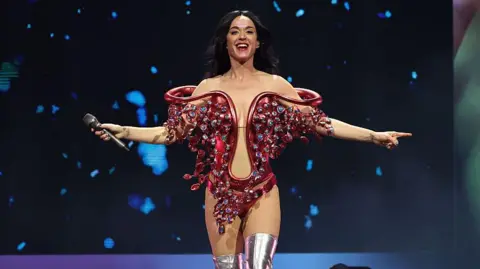In recent weeks, Katy Perry, the well-known pop sensation famous for her catchy hits and vibrant persona, has found herself in the crosshairs of public scrutiny and online backlash. Known predominantly for her bubblegum pop style, Perry expressed feelings of being a “human piñata” following extensive criticism related to her involvement in a Blue Origin spaceflight and her subsequent remarks post-landing. This particular flight, designed as part of billionaire Jeff Bezos’s space tourism venture, has caused her once-bright star to dim in the public’s eye, generating memes and jokes rather than admiration.
Perry’s recent struggles echo the tumultuous nature of celebrity in the digital age, where social media amplifies even the smallest missteps into significant controversies. Mockery followed her emotional reaction upon landing, where she expressed feeling “super connected to life” and “so connected to love.” This response was met with skepticism and derision online, including quips from brands like Wendy’s, eager to capitalize on the moment. Furthermore, her ongoing world tour has faced similar disdain, with critics scoffing at her performances and dance routines. The reaction has raised broader questions about the negative impact of “trends” on artists and their public reception.
Michael Cragg, a music writer and author, theorizes that Perry’s challenges arise from a disconnect with modern pop culture. He asserts that she remains ensnared in a caricature of her past self—one that was defined in the playful, exuberant era of the 2010s. Her earlier music, including the iconic “Teenage Dream,” achieved remarkable success, solidifying her status on the Billboard charts and matching records set by music legends like Michael Jackson. However, as Cragg points out, that success feels distant now. Many perceive that Perry has not evolved in a way that resonates with an ever-changing audience, and her attempts at reinvention have been less than fruitful.
For instance, Perry’s latest single, “Woman’s World,” was intended to serve as a female empowerment anthem, yet critics found it lacking depth and substance, failing to resonate with the fanbase. Adding to this precarious situation was the controversy surrounding Dr. Luke, the song’s producer, who has notable allegations against him. The single barely made an impact on global charts, even further complicating Perry’s musical comeback. Cragg articulates that while messages of love and positivity are endearing, they often do not resonate with “very online” fans who are accustomed to more authentic expressions.
Cragg also notes that Perry’s many attempts to reinvent her image have frequently misaligned with audience expectations, reinforcing a “failed reinvention” narrative. For example, her 2017 album “Witness” sought to introduce a socially conscious theme; however, the juxtaposition of serious messages with more frivolous tracks undermined her efforts, leaving fans confused regarding her true artistic direction.
The pop landscape has shifted significantly over recent years, highlighting a new breed of artists who are characterized by authenticity and self-assurance—qualities that were less prevalent during Perry’s rise to fame. Rising stars like Chappell Roan and Charli XCX have managed to capture audiences with relatable narratives, contrasting with Perry’s struggles to align her brand with contemporary values.
Furthermore, Perry’s attempts to distance herself from her pop persona have not helped her relationship with her audience. The disconnect is palpable as online dialogues shift towards more genuine representations of identity in pop culture. The gravity of Perry’s experiences illuminates a broader challenge faced by female artists in navigating contemporary social media landscapes, where they often face heightened scrutiny, particularly regarding their choices and actions.
In the face of these challenges, Perry remains well-supported by her dedicated fans. For instance, Simon Diego, who leads a passionate fan community, described the backlash towards her as “unbelievable,” while fan initiatives—like a digital billboard display in Times Square—serve as a testament to her enduring influence among loyal followers. Despite the waves of criticism that come her way, the public remains divided, with some fiercely supporting her journey and recognizing the external pressures influencing her public presence.
Katy Perry’s current situation offers a compelling narrative about the interplay of celebrity, social media, and the immense pressures of reinvention in the ever-evolving pop industry. The conversations surrounding her—ranging from critique to robust defense—highlight not only the challenges she faces but also broader shifts within popular music and culture as a whole. It remains to be seen how Perry will navigate this complex landscape, but one thing is for certain: her journey is far from over, and public reception could very well dictate her next moves.



